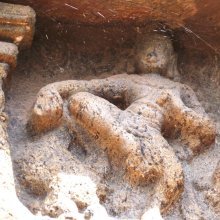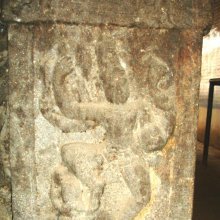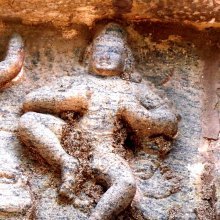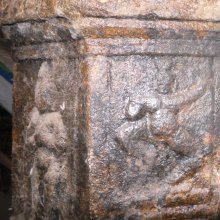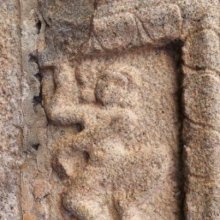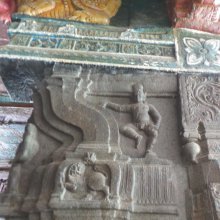Urdhvajanu, Ūrdhvajānu, Urdhva-janu: 10 definitions
Introduction:
Urdhvajanu means something in Hinduism, Sanskrit. If you want to know the exact meaning, history, etymology or English translation of this term then check out the descriptions on this page. Add your comment or reference to a book if you want to contribute to this summary article.
Images (photo gallery)
(+8 more images available)
In Hinduism
Natyashastra (theatrics and dramaturgy)
Source: Wisdom Library: Nāṭya-śāstra1) Ūrdhvajānu (ऊर्ध्वजानु).—One of the 108 karaṇas (minor dance movement) mentioned in the Nāṭyaśāstra chapter 4. The instructions for this ūrdhvajānu-karaṇa is as follows, “a Kuñcita foot to be thrown up, and the knee to be held up (lit. stretched) on a level with the chest, and the two hands to be in harmony with the dance.”.
A karaṇa represents a minor dance movements and combines sthāna (standing position), cārī (foot and leg movement) and nṛttahasta (hands in dancing position).
2) Ūrdhvajānu (ऊर्ध्वजानु) refers to a one of the thirty-two cārīs, according to the Nāṭyaśāstra chapter 11. The Ūrdhvajānu-cārī is classified as a ākāśikī, or “aerial”, of which there are sixteen in total. The term cārī refers to a “dance-step” and refers to the simultaneous movement of the feet (pāda), shanks (jaṅghā) and the hip (ūru). From these cārīs proceed dance as well as movements in general.
Source: archive.org: Natya ShastraŪrdhvajānu (ऊर्ध्वजानु).—A type of aerial (ākāśikī) dance-step (cārī);—Instructions: throwing up a Kuñcita foot and its knee brought up to the level of the breast, and the remaining knee without movement, and then this second foot thrown up in the manner of the first, and the first foot kept motionless.

Natyashastra (नाट्यशास्त्र, nāṭyaśāstra) refers to both the ancient Indian tradition (shastra) of performing arts, (natya—theatrics, drama, dance, music), as well as the name of a Sanskrit work dealing with these subjects. It also teaches the rules for composing Dramatic plays (nataka), construction and performance of Theater, and Poetic works (kavya).
Shilpashastra (iconography)
Source: Archaeological Survey of India: Śaiva monuments at Paṭṭadakal (śilpa)Ūrdhvajānu (ऊर्ध्वजानु) refers to a pose of Śiva depicting another dance sequence of Śivatāṇdava and is found as a sculpture on the first pillar of the southern half of the maṇḍapa of the temple of Trailokyeśvara.—C. Sivaramamurti in his work on Natarāja in Art, Thought and Literature calls this image as Ūrdhvajānu Tāṇdava and interprets it in the following words: “It is almost a jump up with the right leg bent and the knee raised, as required in the description of the karaṇa. Śiva is in jovial mood. In one of the four arms, the main right arm, there is a snake, which he is offering to Pārvatī jokingly, so that she could adorn herself with the jewel, specially as she is admiring her beauty in a mirror she holds in her hand. A Gaṇa and Gaṇapati, to the right and left of Śiva and Pārvatī respectively, appreciate this joke and witness the scene with chuckle.
What looks like a mouse, the vehicle of Gaṇeśa himself, enjoys the fun and jumps at Pārvatī almost in the vein of the nursery rhyme, ‘the cow jumped over the moon’. It can also be seen that Pārvatī is little scared at a snake being brought so close to her and one cannot but be reminded of the verse, which talks of the incongruity of the fearful snake, the jewel of Śiva, in the vicinity of the delicate princess of the mountain kingdom.”
Source: Shodhganga: The significance of the mūla-beras (śilpa)Ūrdhvajānu (ऊर्ध्वजानु) refers to a type of Sthānāsana (poses dependent on the sthānaka), as defined according to texts dealing with śilpa (arts and crafs), known as śilpaśāstras.—One leg is firmly supported on the ground and the other is raised, bent at the knees and supported on a pedestal, or on a higher plane, or on another image. The image of Tripura Samhāra Śiva Mūrti with one leg resting on the ground and the other resting on the top of His chariot and the image or Durgā with one leg resting on the ground and the other placed on the head of Mahiṣ āsura, are good examples of this [Ūrdhvajānu] posture.

Shilpashastra (शिल्पशास्त्र, śilpaśāstra) represents the ancient Indian science (shastra) of creative arts (shilpa) such as sculpture, iconography and painting. Closely related to Vastushastra (architecture), they often share the same literature.
Languages of India and abroad
Sanskrit dictionary
Source: DDSA: The practical Sanskrit-English dictionaryŪrdhvajānu (ऊर्ध्वजानु).—a. [ūrdhvamuccaṃ jānu yasya]
1) raising the knees, sitting on the hams; क्षणमयमनुभूय स्वप्नमूर्ध्वज्ञुरेव (kṣaṇamayamanubhūya svapnamūrdhvajñureva) Śiśupālavadha 11.11.
2) long-shanked.
Ūrdhvajānu is a Sanskrit compound consisting of the terms ūrdhva and jānu (जानु). See also (synonyms): ūrdhvajña, ūrdhvajñu.
Source: Cologne Digital Sanskrit Dictionaries: Cappeller Sanskrit-English DictionaryŪrdhvajānu (ऊर्ध्वजानु).—[adjective] raising the knees.
Source: Cologne Digital Sanskrit Dictionaries: Monier-Williams Sanskrit-English Dictionary1) Ūrdhvajānu (ऊर्ध्वजानु):—[=ūrdhva-jānu] [from ūrdhva] mfn. raising the knees (in sitting), [Śāṅkhāyana-śrauta-sūtra]
2) [v.s. ...] long-shanked, [cf. Lexicographers, esp. such as amarasiṃha, halāyudha, hemacandra, etc.]
[Sanskrit to German]
Sanskrit, also spelled संस्कृतम् (saṃskṛtam), is an ancient language of India commonly seen as the grandmother of the Indo-European language family (even English!). Closely allied with Prakrit and Pali, Sanskrit is more exhaustive in both grammar and terms and has the most extensive collection of literature in the world, greatly surpassing its sister-languages Greek and Latin.
Kannada-English dictionary
Source: Alar: Kannada-English corpusŪrdhvajānu (ಊರ್ಧ್ವಜಾನು):—
1) [noun] he who has relatively longer shanks; a long-shanked man.
2) [noun] a man standing erect.
3) [noun] (dance.) a gesture in which the shank is raised up.
Kannada is a Dravidian language (as opposed to the Indo-European language family) mainly spoken in the southwestern region of India.
See also (Relevant definitions)
Partial matches: Urdhva, Janu.
Starts with: Urdhvajanuka.
Full-text: Urdhvajnu, Urdhvajna, Urdhajanu, Parshvaccheda, Dandapaksha, Alataka, Alata, Carin.
Relevant text
Search found 3 books and stories containing Urdhvajanu, Ūrdhvajānu, Urdhva-janu, Ūrdhva-jānu; (plurals include: Urdhvajanus, Ūrdhvajānus, janus, jānus). You can also click to the full overview containing English textual excerpts. Below are direct links for the most relevant articles:
The Religion and Philosophy of Tevaram (Thevaram) (by M. A. Dorai Rangaswamy)
Chapter 4.3 - (a) Nataraja (the dance of Shiva) < [Volume 2 - Nampi Arurar and Mythology]
Chapter 4.3 - (c) Sculptures of Shiva and Dance < [Volume 2 - Nampi Arurar and Mythology]
Gati in Theory and Practice (by Dr. Sujatha Mohan)
Description of Gati as in Saṅgītamuktāvalī < [Chapter 2 - Concept and technique of Gati]
Performance of Cārī < [Chapter 2 - Concept and technique of Gati]
Natyashastra (English) (by Bharata-muni)
